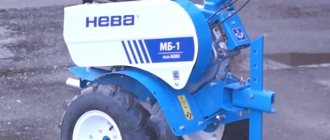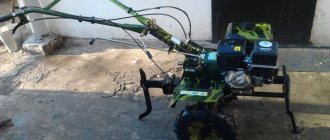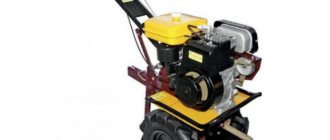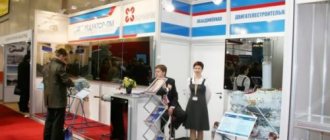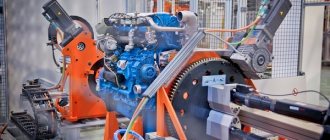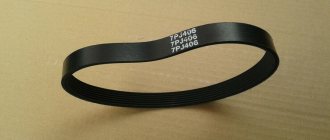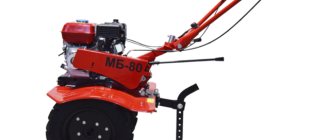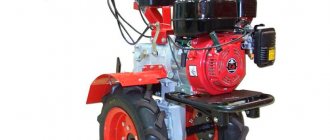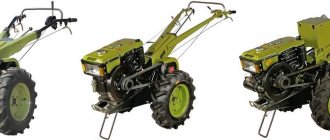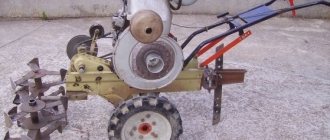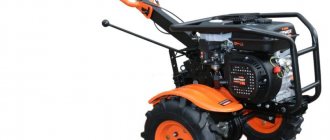Cascade walk-behind tractors are produced by specialized Perm. From 1995 to 2006, production was focused on the production of transmissions for helicopters and gearboxes. But more than 10 years ago, the brand’s specialists mastered the production of single-cylinder 4-stroke engines and Cascade walk-behind tractors.
Modern Cascade walk-behind tractors are distinguished by their quality and reliability, since the manufacturer uses innovative technologies and high-quality materials in its work.
Some of the first models produced at this production were equipped with DM-68 engines. They were quite powerful, but were expensive and produced high levels of vibration and noise. Over the years of the existence of Cascade walk-behind tractors, several more improved modifications of this engine have been released, but in recent years, users have given preference to foreign-made engines (Lifan, Honda, B&S, etc.).
Walk-behind tractor Cascade: main technical characteristics
Any modification of Cascade walk-behind tractors is based on four main structural units - power, chassis, controls and transmission. The power plant includes the engine and its dependent systems. As mentioned earlier, all models of Cascade walk-behind tractors are equipped with motors of domestic and foreign production (more about them later).
The chassis consists of a reinforced frame, wheels (it is possible to install both pneumatic wheels and steel wheels with lugs) and connecting units. An undoubted advantage is the ability to adjust the track width. For ease of use and storage, a special support foot is installed in the front part of the walk-behind tractor.
The transmission of the unit includes a reinforced chain gearbox, clutch and gearbox. The gearbox is four-speed, has 2 forward and 2 reverse speeds. This has a positive effect on the maneuverability of the unit. The gearbox is reliable and resistant to vibration and mechanical damage thanks to the output shaft mounted on large diameter bearings.
The control system is represented by the steering wheel and the control levers themselves (clutch, gas, brake, gearbox). The steering wheel of Cascade walk-behind tractors is adjustable in the vertical plane, which guarantees optimal settings for the operator’s convenience. A comfortable steering wheel position reduces the workload and improves maneuverability of the equipment. Additional comfort when driving is also created by the fact that all control levers, except for the speed lever, are placed directly on the steering wheel.
Repair and maintenance of Cascade walk-behind tractors will not be difficult, since spare parts for it can be freely purchased. To avoid breakdowns and extend the life of your unit, follow these simple rules:
- run-in in accordance with the requirements of the operating instructions;
- monitor the condition of the ignition system, carry out its regular adjustment and cleaning;
- carefully monitor the operation of the gearbox;
- monitor the level and quality of oil and fuel;
- do not exceed the permissible load on the unit.
And of course, do not forget to refer to the operating instructions - the manufacturer always provides them with all the necessary information in an accessible and informative manner.
How to make a clutch for a mini tractor with your own hands?
This question is asked by many farmers who own homemade mini tractors. Before answering it, you should figure out which mechanism is easiest to assemble. There are 2 types of structures that have the simplest design: belt and multi-disc, operating in an oil bath.
The V-belt unit, like other types of units, also consists of driven and main parts. Pulleys act as driven parts.
To assemble the belt coupling you will need:
- 2 belts, at least 14 cm long. They will play the role of forward and reverse gear;
- spring-type rollers – responsible for optimal belt tension;
- 2 guide strips with the same dimensions as the pulley parameters,
- guide plate made of thick, durable steel.
The device of the Cascade walk-behind tractor
In order to assemble the Cascade walk-behind tractor with your own hands, and also to have some repair instructions in case of breakdown, we suggest that you familiarize yourself with the design of the Cascade walk-behind tractor, as well as the technical parameters of its main components.
What engine can be installed on the Cascade walk-behind tractor?
For each owner, one or another engine model has its own subjective pros and cons. We present to you a generalized description of the most popular engines installed on Cascade walk-behind tractors. After familiarizing yourself with it, you will be able to more accurately navigate the models on the market and decide on the choice of engine for your walk-behind tractor.
Engine DM 68
One of the most popular and time-tested engines. The main advantages are the build quality.
Has the following technical characteristics:
- power - 6 l. With.;
- fuel tank volume – 3.3 l;
- plowing depth – 260 mm;
- maximum width during cultivation – 950 mm;
- 4 gears (2 forward, 2 reverse);
- weight – 25 kg;
- fuel consumption – 1.9 l/hour.
Briggs&Stratton engine
A carburetor 4-stroke gasoline engine from an American manufacturer is another excellent option for use on a Cascade walk-behind tractor.
Has the following technical characteristics:
- power - 6.5 or 7.5 liters. With.;
- fuel tank volume – 3.6 l;
- weight – 15 kg;
- fuel consumption – 1.7 l/hour.
Subaru engine
The 4-stroke single-cylinder version running on gasoline is popular. Also, these Subaru engines have an overhead camshaft and a current generator.
More detailed technical specifications:
- power - 6-7 l. With.;
- fuel tank volume – 3.6 l;
- fuel consumption – 1.7 l/hour.
Honda engine
Japanese production deservedly takes its place in the market, since the company's products are known for the quality of parts and great motor potential.
These units have a long service life and high performance.
- power - 6-7 l. With.;
- fuel tank volume – 4.5 l;
- fuel consumption – 1.65 l/hour.
Lifan engine
Gasoline 4-stroke air-cooled carburetor engines. The most popular model for Cascade walk-behind tractors among foreign manufacturers, as it has an optimal price-quality ratio. Its power is 6 liters. pp., average fuel consumption – 1.9 l/hour.
In any case, when purchasing an engine for your walk-behind tractor, always pay attention to the build quality and the absence of mechanical damage or manufacturing defects.
Carburetor problems
The carburetor of the walk-behind tractor may be dirty, and in many cases it may not be adjusted correctly. If this happens, then such a unit is removed and cleaned, its adjustment is carried out, which should be provided for by the rules:
- Another problem may arise, which is expressed in the fact that air does not flow into the carburetor in full. This can happen due to a clogged air filter; ultimately, the fuel mixture comes out over-rich. During use, you should periodically clean the special filter to prevent such problems from occurring. However, if the equipment is used in very dusty conditions, more frequent cleaning may be necessary.
- You should consider the condition of your air filter. Depending on the material in the base, it is necessary to rid the part of dirt using one of the effective methods. If the carburetor of the device begins to receive air in small quantities, then it may be necessary to clean the paper filter, which is done by lightly tapping or blowing.
- If you have a foam filter, you can wash it and then dry it completely. The mesh filter can be cleaned with a vacuum cleaner. Such parts have their own expiration date; as soon as it is used up, the unit will need to be replaced.
So you have learned how to repair the Cascade walk-behind tractor.
Walk-behind tractor Cascade: attachments
Like most walk-behind tractors, Cascade brand units are not without the ability to use additional attachments.
Among the most common types of additional weapons you can find:
- blade shovel;
- cutters of different types;
- trailer for transporting goods;
- potato digger;
- hiller;
- grass mower;
- water pumping equipment;
- rotary snow blower.
Attaching attachments to the Cascade walk-behind tractor occurs in different ways. For example, modules such as a hiller, potato digger or trailer are attached to the walk-behind tractor using special steel pins. Equipment such as a potato planter, snow blower and water pump are attached to the front of the unit, and power is transmitted using a belt.
We also invite you to watch the video, which demonstrates the operation of the Cascade walk-behind tractor with attachments:
Power plant tuning
Its power and equipment performance depend on the stability of the engine. Upgrading a standard engine is very expensive and unpromising. But, there are several ways to make the engine more efficient.
To do this you need:
- Install a quality spark plug. Regularly clean it from carbon deposits and periodically check the clearance. At the first sign of loss of power, replace the spark plug.
- Use the best gaskets on all connections. This allows you to maintain the required pressure in the unit, preventing a decrease in power and the formation of smoke during operation.
- Fill the engine with the best oil to the upper mark. It should be remembered that when the unit is tilted, oil flows away from the rubbing parts.
- Check the quality of fuel before filling the tank. It is advisable to let it sit for a while so that the water sinks to the bottom of the container. The tank itself must be cleaned and wiped dry every 2-3 days.
- Install an additional radiator. To do this, steel plates are welded to the engine housing, which will effectively remove excess heat.
Manufacturing of additional accessories
Walk-behind tractors go on sale assembled and with minimal equipment. A plow and a cutter are clearly not enough to perform the entire volume of agricultural work. A factory kit for converting a walk-behind tractor can cost more than the unit itself. You can make various attachments and trailers from scrap materials, using tools that are in every pantry of a country house or cottage.
It is worth considering some options for making additional equipment yourself:
- A converted rake for collecting grass clippings, debris, branches and fallen leaves. If you do this work manually, it will take a lot of time and effort. Trailed equipment will allow you to clean large areas within a few minutes. To work, you will need a wide strip of sheet iron and several meters of reinforcement with a cross section of 8-12 mm. The reinforcement must be cut into pieces 10 cm long and welded to the plate in several rows and at intervals of 3-4 cm. Long rods are welded to the plate for attaching to the walk-behind tractor frame. Trailed rakes can be equipped with rollers to improve maneuverability and smoothness.
- Snow plow. Most units operate much more efficiently in the cold because they do not overheat. You can mechanize snow removal in winter. The blade is made from two pieces of channel welded together. This allows you to get a gripping height of up to 40 cm. The width of the blade is selected according to the power and weight of the unit within 40-80 cm. The blade is attached rigidly to the front of the machine with bolts. Initially, it can be mobile or stationary.
- Trolley and trailer. The walk-behind tractor cannot be driven on the road, so it does not have to be adjusted to the requirements of the traffic rules. The cart is made from a corner, a channel and old wheels from a small car, and a trailer is attached to it. It is made from metal profiles and boards. The towing clutch is made standard, like for cars or tractors.
By showing a creative approach, you can make a hiller, harrows and potato digger that are not inferior in quality to their factory counterparts.
Rules for operating and maintaining the unit
During the first hours of operation, you need to put a gentle load on the Cascade walk-behind tractor. The owner's manual recommends a 35-hour break-in cycle. During this time, the following conditions must be observed:
- within 5 min. the engine warms up at medium speed;
- work is carried out in first gear and medium speed;
- after 5 hours of operation, the oil must be replaced;
- the next portion of oil is changed after 5-7 hours;
- then the oil is changed after 35 hours;
- All connections are inspected and bolts are tightened.
In the future, for 1-2 months you should not give the maximum load to the unit. It is necessary that all parts get used to each other.
Maintenance should be carried out during operation. It comes down to these points:
- daily removal of dust and oil from surfaces;
- monitoring and pulling fastenings if necessary;
- belt inspection. Replacement in case of delamination;
- checking the fastening of attachments;
- The oil in the gearbox is changed every 50 hours.
When replacing a belt, you need to pay attention to the indices stamped on them. They come in A1180 and A1400.
During the work, the steering wheel is set at the required height, which is kept parallel to the ground. Skew is not allowed. Otherwise, the unit will bury itself in black soil. The depth of soil cultivation is 200 mm, and in difficult areas 100-150. If the ground is rocky, then work is carried out in first gear.
Storage is carried out in a dry room or outdoors under a tarpaulin. In case of preservation, all unpainted parts are coated with K1 lubricant. Storage time - 1 year. If longer storage is necessary, the lubricant is changed.
